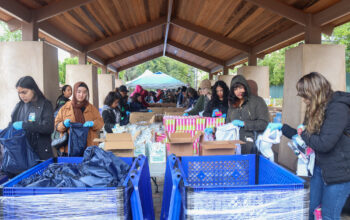This year’s Farm Walk hosted more than 10,000 people, far more than the number of attendees at past Farm Walks.
This rise in attendance is significant in comparison to the 6,000 people who attended last year’s Farm Walk.
“I cried when a group of kindergarteners handed me an envelope with more than $500 in it,” Leland Shapiro, head of Department of Agriculture, said.
Though the event was free, the department requested each attendee to donate $5 at the entrance to help pay for animal feed and tractors, Carol Kozeracki, dean of research, planning and enrollment management, said.
After paying the bills from Farm Walk, which sum up to around $4,000, Shapiro knows that he will have at least $17,000 of profit from the event, he said.
Farm Walk offered activities including animal feeding, a petting zoo, a pie-eating contest, face painting and horse shows that were located throughout the farm.
“We had a full and solid crowd until 3 p.m. from the information booth at the entrance all the way to the sheep unit,” Shapiro said. “I couldn’t even get my car through the people.”
Since the farm does not house cows, Shapiro also arranged for a dairy mobile unit to come to the Farm Walk and teach children how to milk a cow by hand, Efrain Valenzuela, manager of the dairy mobile unit, said.
With the $17,000 in profit, Shapiro plans to maintain four to five pastures, which will not only cut down animal feed cost by half, but would provide animals the opportunity to walk around pastures more often, he said.
So far, this semester, the farm has received around $200,000 in donations.
Shapiro said that he is saving $150,000 of these donations for student labor during the next three years.
“Students need help going through school, and we need their help to maintain the farm,” he said.
Shapiro believes that the reason for the “greater turnout” is the news articles featured in the Roundup, the LA Times and the Daily News.
“I think the community now understands that the farm belongs to them, and they demand it stays here,” he said.
Since the community pays taxes for the existence of the college, as well as the farm, Shapiro intends to involve the community as much as he can.
“I consider my boss the community,” he said.
Contributing: Kal Valasek



